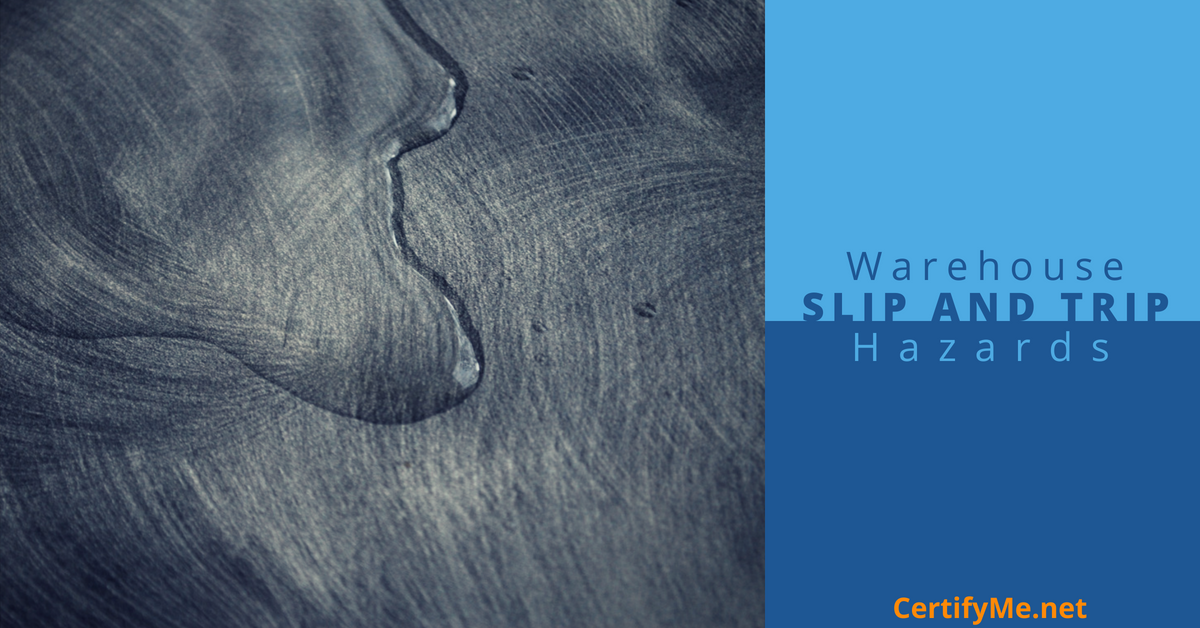Warehouse Slip, Trip, and Fall Hazards: How to Stay OSHA Compliant
Posted by: admin on April 16, 2025

Forklift operations, merchandise handling, poor lighting, and unexpected spills all contribute to the hidden dangers lurking inside warehouses. These busy environments experience a significantly higher rate of accidents compared to offices or retail spaces. Reducing warehouse trip hazards starts with proper planning, employee training, and constant vigilance.
Why Warehouse Slip, Trip, and Fall Safety Matters
Approximately 20% of all workplace fatalities result from slip, trip, and fall incidents according to OSHA. Warehouses present an even greater danger due to heavy machinery, pallet stacking, and high-traffic areas. Raising employee awareness and building a strong safety culture can dramatically reduce these preventable accidents.
OSHA Regulations for Warehouse Trip and Slip Hazards
OSHA requires that all walking-working surfaces be kept clean, dry, and hazard-free. Regular inspections must take place to identify potential dangers before injuries occur. Clear aisles, immediate spill cleanups, and strict maintenance routines fall under OSHA’s Slip, Trip, and Fall (STF) compliance rules, creating safer spaces for every worker.
Common Warehouse Trip Hazards
Pallets Left on the Floor
Stray pallets, broken boards, and carelessly stacked goods often cause serious tripping incidents. Keeping floors clear and removing damaged materials promptly can dramatically cut accident rates.
Poor Lighting
Dim lighting obscures visibility, increasing the likelihood of unseen obstacles causing falls. Installing brighter, well-placed lighting systems creates safer passageways and reduces overall injury risks.
Merchandise Spills
Unsecured goods or dropped inventory items create unexpected dangers underfoot. Staff should immediately clear any fallen merchandise to avoid hazardous pileups across busy warehouse floors.
Common Warehouse Slip Hazards
Water, Ice, and Weather Conditions
Cold storage areas, loading docks, and winter storms introduce wet surfaces prone to slips. Consistent monitoring of temperature-sensitive zones keeps these hazards under control year-round.
Oil Leaks and Spills
Forklifts leaking hydraulic fluid, motor oil, or other slippery substances pose a major slip threat. Prompt maintenance and routine inspections catch leaks early before they create serious problems.
Food Product Spills
Spilled powders, liquids, and frozen goods from warehouse inventory frequently create slick surfaces. Implementing fast response procedures helps prevent injuries and contamination.
Warehouse Fall Prevention Strategies
Daily Inspections
Start every shift with a thorough check of flooring conditions, shelving stability, and forklift travel paths. Spotting problems early ensures fast fixes and uninterrupted operations.
Employee Awareness Training
Educating staff to identify, report, and correct hazards creates an extra line of defense. Routine safety talks and refresher courses reinforce best practices year-round.
Spill Response Procedures
Quick containment and cleanup actions limit exposure and injury risk. Assign teams or individuals specific spill response duties during each shift for faster reactions.
Protective Gear
Non-slip footwear, hard hats, and appropriate personal protective equipment (PPE) provide an additional safety layer against unpredictable hazards.
FAQs About Warehouse Slip, Trip, and Fall Safety
What Are the Most Common Warehouse Trip Hazards?
Loose pallets, unsecured inventory, and poor visibility are the leading causes of warehouse trip incidents.
How Can I Prevent Warehouse Slip Hazards?
Immediate cleanup of spills, installation of absorbent mats, and regular inspections prevent most slip injuries inside warehouses.
Does OSHA Require Training for Slip, Trip, and Fall Safety?
OSHA mandates hazard communication and employee training programs focused on workplace-specific risks, including slips, trips, and falls.
Can Forklift Drivers Be Involved in Slip, Trip, and Fall Accidents?
Yes, forklift operators are vulnerable to falls during mounting, dismounting, or while moving loads in poorly maintained warehouse areas.
Build a Safer Warehouse with CertifyMe
Strengthening your warehouse safety starts with proper forklift certification. CertifyMe delivers fast, affordable OSHA-compliant forklift training online, covering slip, trip, and fall prevention as part of its core curriculum. Get certified in hours, enjoy free three-year renewals, and protect your team with 24/7 access to vital safety education through CertifyMe.
Welcome to CertifyMe.net
CertifyMe.net has offered online forklift certification since 1999. With Our Convenient online program. your employess can earn their certification in an hour or less.
Browse Online Certifications:
This low-cost program can be compeleted anytime, anywhere!





